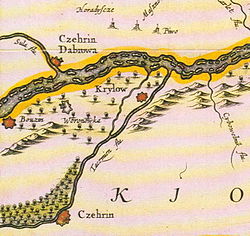Top Qs
Timeline
Chat
Perspective
Russo-Turkish War (1672–1681)
Second conflict of the Russo-Turkish wars From Wikipedia, the free encyclopedia
Remove ads
The Russo-Turkish War of 1672–1681, a war between the Tsardom of Russia and Ottoman Empire, caused by Turkish expansionism in the second half of the 17th century. Is the largest and one of the most important series of military campaigns before the Great Turkish War.[1]
Remove ads
Prelude
Summarize
Perspective
After having captured and devastated the region of Podolia in the course of the Polish–Turkish War of 1672–1676, the Ottoman government strove to spread its rule over all of Right-bank Ukraine with the support of its vassal (since 1669), Hetman Petro Doroshenko. The latter's pro-Turkish policy caused discontent among many Ukrainian Cossacks, which would lead to the election of Ivan Samoilovich (hetman of the Left-bank Ukraine) as the sole hetman of all Ukraine in 1674.
Despite this, Doroshenko continued to keep Chyhyryn, an important Cossack town near the Dnieper river. He cleverly maneuvered between Moscow and Warsaw and used the support of the Turkish-Tatar army. Finally, the Russian and Ukrainian forces under the command of Samoilovich and Grigory Romodanovsky besieged Chyhyryn and forced Doroshenko to surrender in 1676. Leaving a garrison in Chyhyryn, the Russian and Ukrainian armies retreated to the left bank of the Dnieper.
The supply of Ottoman forces operating in Moldavia and Wallachia was a major challenge that required well organized logistics. An army of 60,000 soldiers and 40,000 horses required a half-million kilograms of food per day. The Ottoman forces fared better than the Russians, but the expenses crippled both national treasuries. Supplies on both sides came using fixed prices, taxes, and confiscation.[2]
Remove ads
1677 Campaign
Summarize
Perspective
The Ottoman Sultan Mehmed IV appointed Yuri Khmelnitsky, who had been the sultan's prisoner at that time, hetman of Right-bank Ukraine. In July 1677, the sultan ordered his army (45,000 men) under the command of Ibrahim Pasha to advance towards Chyhyryn.[3] On 30 July 1677, advanced detachments appeared at the fortress, and on August 3 – the main Turkish forces. Samoilovich and Grigory Romodanovsky's army joined on August 10, and only on August 24 did they cross the Sula river on the way to Chyhyryn. On August 26–27, a skirmish between their and Ottoman troops removed Ottoman observation posts and allowed the rest of the Russian and Ukrainian forces to cross the river under the cover of artillery fire. Turkish attempts to drop back into the river at the first crossing detachment under the command of Major-General Shepelev were repulsed. Russian and Ukrainian cavalry attacked and overwhelmed the Turkish-Tatar army camp on August 28, inflicting heavy casualties. The following day, Ibrahim Pasha lifted the siege of Chyhyryn and hastily retreated to the Inhul river and beyond.[4] Samoilovich and Grigory Romodanovsky relieved Chyhyryn on September 5. The Ottoman Army had lost 20,000 men and Ibrahim was imprisoned upon his return to Constantinople and Crimean Khan Selim I Giray lost his throne.[5][6]
Remove ads
1678 Campaign
Summarize
Perspective

I - Central bastion or "bulwark" of the New Castle
II - Bastion ("dungeon") of Doroshenko
III - Bastion with the Crimean Tower
IV - The Spassky Gate with a wooden tower and a double ravelin in front of them
V - Wooden tower on a stone foundation, "New Goat Horn"
VI - Tower and the well
VII - Stone corner bastion
VIII - Stone round tower
IX - The Kyiv Tower with a gate to the bridge
X - Noname tower (just built in 1678)
XI - The Korsun or Mill Tower
XII - Gate to the Lower Town
In July 1678, the Turkish army (approx. 70,000 men) of the Grand Vizier Kara Mustafa with the Crimean Tatar army (up to 50,000 men) besieged Chyhyryn once again.[5] The Russian and Ukrainian armies (70,000–80,000) broke through the fortified position of the Turkish covering force and turned them to flight. Then they entrenched on the left bank of the Tiasmyn river opposite the fortress with the Turkish-Crimean army on the other bank. The crossings were destroyed and it was difficult to attack the Turks. The troops could freely enter Chyhyryn, but it was already surrounded by well-equipped siege positions and was heavily bombarded; its fortifications were badly damaged. When the Turks broke into the Lower Town of Chyhyryn on August 11, Romodanovsky ordered to leave the citadel and withdraw troops to the left bank. The Russian army retreated beyond the Dnieper, beating off the pursuing Turkish army, which would finally leave them in peace. Later the Turks seized Kanev and established the power of Yuri Khmelnitsky on Right-bank Ukraine, but did not go to Kiev, where the Russian troops were stationed.[7] During the campaign 12,000–20,000 Turkish-Tatar troops were killed, while around 17,000 Cossack-Russian troops were killed or went missing during the campaign.[8] According to other estimates, Ottomans lost over 30,000 troops.[9]
In 1679–1680, the Russians repelled the attacks of the Crimean Tatars and signed the Bakhchisaray Peace Treaty on 3 January 1681, which would establish the Russo-Turkish border by the Dnieper.[10]
Remove ads
Result of the war
The result of the war, which was ended by the Treaty of Bakhchisarai, is disputed. Some historians mention it was an Ottoman victory,[a][11][12][13] while another historian contends that it was a Russian victory.[14][15][b][16] While some historians state the war was indecisive (stalemate).[c][17][d][18][19]
Notes
- "Despite the loss of Chyhyryn the war aims of greatest importance to Moscow were therefore achieved. Khan Murat Girei was compelled to negotiate at Bakhchisarai a twenty-year armistice with Muscovy formally acknowledging Kiev and the Left Bank as Muscovite possessions. Murat Girei played a crucial role in subsequently inducing Sultan Mehmed IV to ratify these same terms. For Mehmed IV and Grand Vizier Kara Mustafa the destruction of Chyhyryn was thereby rendered a Pyrrhic victory."[16]
Remove ads
References
Sources and further reading
Wikiwand - on
Seamless Wikipedia browsing. On steroids.
Remove ads

